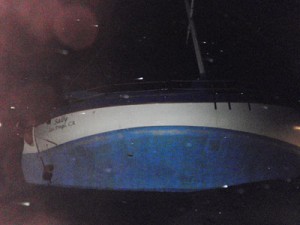TowBoatUS San Diego salvages multiple boats as 50 knot winds hit San Diego Bay
Winds clocked at over 55 knots, water spouts, and heavy rain hit San Diego bay blowing boats aground. Vessel Assist San Diego deployed three salvage teams throughout the bay in efforts to salvage vessels before they broke apart on San Diego beaches and jetties. Captain Tony Olson was the on-water salvage coordinator aboard Vessel Assist “Shelter Island.” The locations of the stranded vessels made each salvage effort a dangerous operation. 
The first case was a 45′ Sloop sailboat that broke moorage in the “Rock and Roll” moorings. The vessel slammed aground during the height of the storm and ended up aground with the bow facing the rocks in a shoal area. Robert Butler, the land Salvage coordinator, operated one of Vessel Assist San Diego’s 4×4 truck salvage trucks equipped with a 12,000 pound winch. After driving as far up the beach and into the water as he could, he used the winch to pull the sloop sideways and into a position where the boat could be pulled by the 900hp Vessel Assist “Shelter Island.” The obvious hazard that had to be addressed was that there were a dozen boats moored just a few yards from where Captain Tony Olson needed to apply the horsepower. Captain Shane Thompson swam the line into the beach and then back out from the truck. After attaching the lines he stood ready at the helm to steer the stricken vessel thru the maze of boats. Once the sloop was freed from the rocky beach and steered into deep water it was passed off to Captain Reggie Curry and crew to assess damage and deliver to Shelter Island Boatyard.
The second case was a 32′ sailboat just a hundred yards from the 45′ sloop. The wind had blown this vessel to the beach and with the falling tide came to rest lying on its side with the low side of the boat facing the bay and the weather. Captain Tony Olson gathered his salvage team and maneuvered Vessel Assist “Shelter Island” into position. With the tide rushing in and the wind blowing, keeping the Shelter Island on point was only possible because of the expert boat handling of Captain Tony. Captain Travis Basom worked the lines on the deck while Captain Shane swam the salvage line to the grounded boat. Again, with a dozen boats in direct line and the average depth in the pull zone only 3′ deep, the Vessel Assist “Shelter Island” had to bounce off the bottom digging the props in the mud several times during the pull. Designed to be grounded, the “Shelter Island” needed all 900 HP to pull the heavy sailboat loose from the beach. Again, Captain Shane  steered through the maze of boats and delivered to Shelter Island Boat yard.
steered through the maze of boats and delivered to Shelter Island Boat yard.
While this salvage effort was under way, Vessel Assist boat “San Diego” was called to salvage a 42′ Chris Craft sinking in its slip at the pier 32′ Marina in South Bay. As Captain Reggie and crew arrived on scene the 42′ boat was listing heavily and looked to be ready to go under. The crew of Vessel Assist “San Diego” had their salvage pumps ready and were pumping within seconds of getting on scene. Thanks to the power take off pump, which runs off the main engine at a pumping rate of 9000 gallons per hour, the vessel was pumped out and the leak found and stopped.
As Vessel Assist “San Diego” was rescuing the sinking boat, Vessel Assist “Shelter Island” and the Vessel Assist land salvage team arrived on scene to what was the toughest salvage of the night. A 44′ Power boat dragged anchor and tangled with a 36′ Ferrocement Sail boat. While hanging the cement boat’s anchor and dragging it aground, it helped save the power boat by holding just few feet away from a cement pier and rocks next to the USCG station. Captain Butler and his land salvage crew had to climb over a 8′ fence with barb wire on top just to get to the wreck. Once Captain Olson got into position, Captain Shane swam in to the boat wading through thick mud, rocks, and cement chunks of rubble. With the assistance of the land team, a bridle was attached to the boat and Shane began untangling anchor lines. Because the cement boat was in direct line of the power boat and was sunk , Captain Tony had to pull the power vessel around the cement sailboat into deep water. Once in deep water the power boat was delivered to a dock for assessment of damage. 
With Dawn coming and a high tide, the salvage teams met at base to straighten up the equipment and eat. Float bags and pumps were loaded to salvage the cement vessel . As the tide dropped the boat was pumped out and float bags were inflated and when the tide came back in, water was pumped from the boat until the vessel was floated and pulled from the rocky beach. The 36′ Ferrocement sailboat was taken to Knight and Carver boat yard for haul out.
With winter still a week away Vessel Assist San Diego urges all boaters to prepare their boat by checking the bilges and securing lines, also make sure that your Marina has emergency contact information and your current insurance information on hand.

